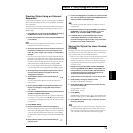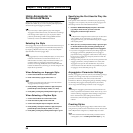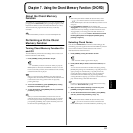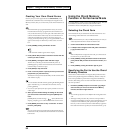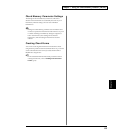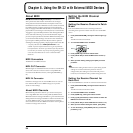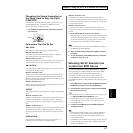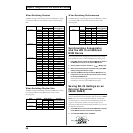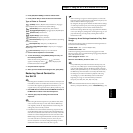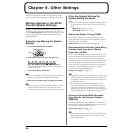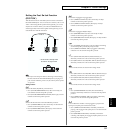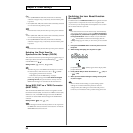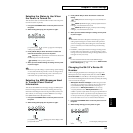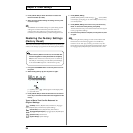
87
Chapter 8. Using the SH-32 with External MIDI Devices
Chapter 8
Changing the Sound According to
the Force Used to Play the Keys
(VELOCITY)
You can use the variations in the force used to play the keys of an
external MIDI keyboard connected to the MIDI IN connector
(Velocity messages) to modify the sound.
1. Turn the MIDI settings knob to the “VELOCITY” parameter
you want to set.
fig.08-05.e
Parameters That Can Be Set
AMP LEVEL
This changes the volume according to the keyboard touch.
When the value set is 1–63:
The volume increases the more forcefully the keys are pressed,
approaching the volume set for the Patch (p. 59).
When the value set is -63– -1:
The volume decreases the more forcefully the keys are pressed. The
volume is lowest when the keys are played with the most force.
AMP ATTACK
This changes the attack time of the volume (“A” portion of A D S R)
according to the keyboard touch.
When the value set is 1–63:
The time for the attack portion of the envelope becomes shorter the
more forcefully the keys are pressed, yielding a sharper attack for
the sound. The time approaches the length set for the Patch (p. 58) as
the keys are played with less force.
When the value set is -63– -1:
The time of the attack portion of the envelope becomes longer as the
keys are pressed with greater force.
CUTOFF
This changes the filter’s cutoff frequency according to the keyboard
touch.
When the value set is 1–63:
The more forcefully the keys are played, the further above the value
set for the Patch (p. 57) the cutoff frequency becomes. The cutoff
frequency approaches the set value as the keys are played with less
force.
When the value set is -63– -1:
The more forcefully the keys are played, the further below the value
set for the Patch (p. 57) the cutoff frequency becomes. The cutoff
frequency approaches the set value as the keys are played with less
force.
FILTER ATTACK
This changes the attack time of the filter’s cutoff frequency (“A”
portion of A D S R) according to the keyboard touch.
When the value set is 1–63:
The change in the cutoff in the attack portion of the sound (“A”
portion of A D S R) becomes faster the more forcefully the keys are
pressed; the rate approaches that set for the Patch (p. 57) as the keys
are played with less force.
When the value set is -63– -1:
The change in the cutoff in the attack portion of the sound (“A”
portion of A D S R) becomes slower the more forcefully the keys are
pressed.
2. Press [VALUE ▼/▲] to select the value (-63–63).
When the value is set to “0,” the sound is played according to the
value set for the Patch, regardless of the velocity. The change in
the sound in response to your playing dynamics increases the
more the value is increased above or lowered below “0.”
You can set the parameter only when the indicator to the left of
the MIDI settings knob is blinking.
3. When you finish making settings, press [EXIT] to end the
procedure.
4. To save the settings, press [WRITE] and carry out the write
procedure (p. 63, p. 70, p. 73).
Selecting SH-32 Sounds from
an External MIDI Device
By transmitting Bank Select messages (MIDI controller number 0
and 32) and Program Change messages from the external MIDI
device to the SH-32, you can select Patches, Rhythm Sets, or
Performances. In other words, when you select sounds on an
external MIDI device, the corresponding MIDI message will be
transmitted to the SH-32, causing the SH-32 to select the appropriate
Patch, etc.
1. Use a MIDI cable to connect the SH-32’s MIDI IN connector to
the MIDI OUT connector of the external MIDI device.
2. Set the SH-32’s receive channel to match the external MIDI
device’s transmit channel.
• For instructions on how to set the SH-32’s receive channel, refer
to “Setting the MIDI Channel (MIDI CH)” (p. 84).
• For instructions on how to set the transmit channel of the
external MIDI device, refer to the owner’s manual for your
external MIDI device.
3. From the external MIDI device, send a MIDI message for
changing the sound.
• If the Program Change numbers on your external MIDI device
are referenced as values from 0 to 127, find the appropriate
number by subtracting 1 from the number in the following
correspondence chart.
• If the SH-32 receives no Bank Select messages, but only Program
Change messages, it can switch only to sounds within certain
banks, such as BANK A/B.
blinking



